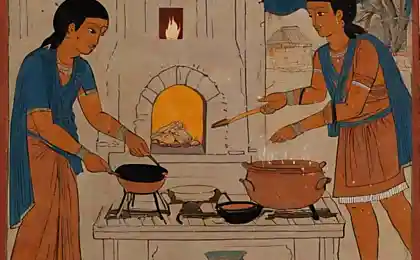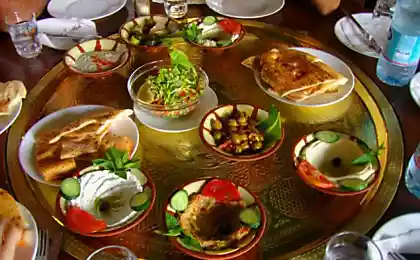350
Culinary traditions of different countries: interesting facts and recipes

Introduction. Cooking is one of the oldest manifestations of human culture, formed under the
influence of local history, climate, religion and social traditions. Many ethnographers claim that the kitchen is a
A bridge between generations to preserve national identity. Not surprisingly, farmland
Provence before the bustling markets in Thailand, gastronomic customs reflect not only the peculiarities of agriculture.
It's also the way of life, the social structures and even the philosophy of whole nations.
In this article, we will analyze the uniqueness of culinary traditions of different continents, consider
A few interesting facts and share recipes of national dishes that can decorate your home table.
We will try to look deeper than just a set of ingredients and cooking method to show the true story.
The relationship between culture, routine and eating habits. According to the United Nations Food and Agriculture Organization (FAO),
issues of nutrition and preservation of traditions are becoming more and more relevant in the modern conditions of globalization.
A shift to "universal" tastes could erase the uniqueness of local cuisines and gastronomic heritage.
1. Global Gastronomy Heritage
Every culture is influenced by natural conditions. In the arid regions of the Middle East for centuries
Improved methods of water conservation and cooking with a minimum amount of liquid.
In the Scandinavian countries, on the contrary, traditionally smoked and dried fish or meat, to protect them from rapid
damage in cold conditions. In Asia, for centuries developed spicy sauces that allow you to save food
longer and maintain a rich taste.
If we delve into history, we will notice that the culture of food is directly related to the development of fire.
agriculture. The transition to a sedentary lifestyle largely laid the foundation for the emergence of regional cuisines.
passed down from generation to generation. Changes of eras were often made by colonization, trade routes, and
migratory flows brought exotic spices and ingredients to local diets, changing the taste palette
entire civilizations. According to researchers from the World Health Organization (WHO),
Other factors—religion, social status, and even gender roles—also influenced how and what people ate.
corners of our planet.
2. Europe: from refined Provence to hearty Scandinavia
European cuisine is extremely diverse. French cooking, for example, is often associated with subtleties.
sauces, exquisite desserts and the idea of gourmet. Italy is famous for pasta, pizza and simple, but incredible
fragrant dishes. Scandinavian countries - Denmark, Norway, Sweden - made a great contribution to the culture of the "new world".
Nordic cuisine is focused on local and seasonal products, minimalism and health.
Interesting fact.
It is believed that the first book of recipes was published in Europe. Manuscript of "De re coquinaria" (attributed to
The famous Roman gourmet Apitius is one of the oldest evidences of how the Romans experimented.
with ingredients, although many records seem extravagant to the modern reader.
Recipe from Europe: Traditional Italian brusketta
- Chiabatta (or other white bread) – 1 loaf
- Extra Virgin olive oil - about 3 tbsp. l.
- Ripe tomatoes - 2-3 pieces
- Garlic - 1 clove
- Salt, pepper, basil to taste
- Cut the bread into slices and toast lightly on the grill or pan.
- Rub each slice with garlic, spray with olive oil.
- Cut the tomatoes in small cubes, mix with salt, pepper and basil.
- Put the mixture on the bread and immediately serve to the table.

3. Asia: diversity of tastes and aromas
Asian cooking includes dozens of different cuisines, each combining sophisticated techniques and vibrant cuisines.
ingredients. Chinese cuisine, divided into “main” directions (Sichuan, Guangdong, Shandong, Huayang), amazes.
rich in spices and sauces. Japan focuses on freshness of products: principles developed here
preserve the natural taste of fish and vegetables. Indian cuisine is famous for a variety of seasonings and masala mixtures,
combining dozens of herbs and spices.
Interesting fact.
In some parts of Asia, such as China and Cambodia, insects are traditionally eaten. From the point
According to FAO, this can solve some of the problems associated with the
Protein shortages and environmental pressures on agriculture.
Recipe from Asia: Classic Thai Pad Thai
- Rice noodles - 200g
- Chicken fillet or shrimp - 200g
- Shallots, 1 pc.
- Tamarind sauce is 2 tbsp.
- Fish sauce - 1 tbsp.
- Sugar is 1 tbsp.
- Green onions, peanuts, soy sprouts to taste
- Boil the rice noodles until half ready, then rinse with cold water.
- Roast sliced chicken or shrimp in vegetable oil.
- Add the shallots, roast until golden.
- Mix tamarind, fish sauce and sugar, pour into the pan.
- Put the noodles down and mix well. Add the green onions and peanuts.
- At the end, add the soybean sprouts and roast for about a minute.
4. American Culinary Traditions: From North to South
The American continent is not only fast food from the United States, but also an incredibly original cuisine of Latin America.
Mexico is famous for corn tortillas, chillies and dishes with the addition of creative sauces based on peppers. In
Peruvian cuisine one of the crown dishes is ceviche - fish marinated in lime juice, with the addition of spicy
peppers and onions.
North American gastronomic culture is a unique mix of traditions of Indian peoples, immigrants.
Europe, Africa and Asia. That is why in the US menu you can see classic barbecue dishes, Indian corn.
Cakes, Chinese noodles and Italian pizza. This phenomenon of "melting pot" is often discussed by sociologists and
According to historians, “American cuisine” consists of regional cuisine.
strata (South, Texas, New Orleans, etc.) and ethnic influences.
Interesting fact.
In Brazil, kshassa is a local alcoholic drink made of sugar cane, used in Brazil.
It's a kaipiriña. The recipe is as simple as it is popular: lime juice, ice, kchassa and some sugar.
Despite the fact that the drink has become a symbol of Brazilian nightlife, its flavor range varies greatly.
different regions.
Recipe from America: Mexican tacos with beef
- Ground beef - 300g
- Onions - 1 pc.
- Tomato paste - 2 tbsp.
- Spices (chilli, paprika, cumin) to taste
- Tortillas - 6 pieces
- Salad, tomatoes, topping cheese
- Roast the finely chopped onions until transparent.
- Add the mince and cook until the liquid has completely evaporated.
- Add tomato paste, spices, some water, stew for 5 minutes.
- Heat the tortillas in the oven or pan.
- Put the stuffing of minced meat, lettuce, sliced tomatoes and sprinkle with grated cheese.

5. Africa and the Middle East: colorful spices and traditions of hospitality
African cuisine is often underestimated by tourists, although it is on this continent that many modern cuisines were born.
Variety crops, including coffee (Ethiopia) and millet. North African countries such as Morocco and Tunisia are famous
A combination of Arab, Mediterranean and Berber traditions. Their dishes (couscous, tazin, pastille) are often used.
rich sets of spices (zira, coriander, cinnamon), which give food a rich aroma.
In the Middle East extremely popular hummus, falafel, shawarma and many dishes based on legumes and
crops. Long-grain rice is common in Saudi Arabia and other Gulf countries.
Dates and lamb. Hospitality here represents an important socio-cultural practice - guests accepted
Treat the best dishes and serve the table with great care.
Interesting fact.
In Ethiopia, there is a unique tradition of drinking coffee - "coffee ceremony", during which the beans are grown.
First roasted with guests, and then brewed in a special clay vessel "jeben". Researchers
emphasize that this ritual is not only important for culture and communication, but also acts as a kind of ritual.
A social institution that strengthens ties in society.
Recipe from Africa: Moroccan Vegetable Tagin
- Olive oil is 2 tbsp.
- Onions - 1 pc.
- Carrots, squash, Bulgarian pepper - 1-2 pieces.
- Chickpeas (boiled) - 1 cup
- A mixture of spices "ras el khanut" - 1 tsp.
- Tomato paste - 1 tbsp.
- Salt, pepper, to taste.
- Roast the onions until golden.
- Add sliced vegetables and spices, stir.
- Put chickpeas and tomato paste, pour in some water.
- Stew under the lid until the vegetables are soft (about 20 minutes).
- Serve with couscous or bread.
Conclusion
The culinary traditions of the world are an extensive kaleidoscope of tastes, aromas and cooking methods, in which they are reflected.
both history and modernity. From refined French sauces to fiery Mexican tacos, from Japanese philosophy
"Freshness above all" to Moroccan spicy tazhins - each kitchen tells its own story and shapes its own culture.
cultural code of the nation. Most experts agree that the gastronomic heritage is in need of
preservation and development, because it not only contributes to the tourist attractiveness, but also preserves
cultural identity of peoples.
It is important to remember that cooking is a creative process and always open to experimentation. All of them.
Recipes can be adapted to your own taste, replacing some ingredients or adding new spices. But
It is worth respecting the traditions that made these dishes so beloved by millions of people. Maybe.
It is thanks to the combination of ancient customs and new trends that the world cuisine remains so diverse.
Inspiring and unifying.
Secrets of centenarians: what unites the world's "blue zones"
The Art of Photography: How to Take Beautiful Pictures on Your Phone























